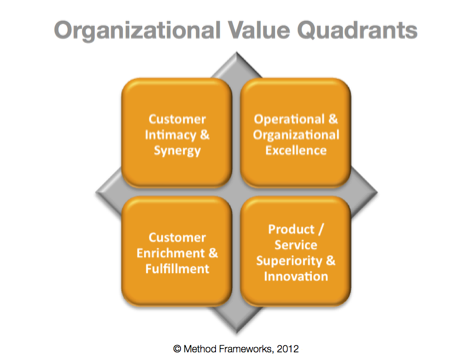Does Your Culture Match Your Business Model?

 An understanding how organizational culture and business service models align is the bedrock foundation to form strategy upon – yet this critical relationship is often missed in organizational development and planning. In last week’s post, four primary business model signatures were outlined. This article examines the components of culture as well as the most common cultural signatures, exploring the alignments of those with organization structure.
An understanding how organizational culture and business service models align is the bedrock foundation to form strategy upon – yet this critical relationship is often missed in organizational development and planning. In last week’s post, four primary business model signatures were outlined. This article examines the components of culture as well as the most common cultural signatures, exploring the alignments of those with organization structure.
What Do We Really Mean By The Term “Business Culture” Anyway?
Organizational culture is more important than it is generally given credit for, but not for the reasons many might think. The culture of an organization is complex and comprised of many layers, making it difficult for many business executives to fully appreciate. Not understanding your culture means not understanding how it affects your customers. That is because culture is related to all aspects of the business, including the service models supported by the business and the structure of the organization formed in support of those models.
The cultural landscape of a business is dotted with numerous characteristics and attributes that make the terrain like a fingerprint that is unique to that organization. The daily behavior and actions of the people in the organization form the rituals and routines that are perpetuated as new employees are hired. The culture is interwoven in stories about past events and and experiences that occurred along the evolution of the organization, each containing a message to demonstrate an example of fidelity to the organization’s core values. In fact, most companies immortalize revered leaders as role models in cultural lore, helping further demonstrate to all current and future employees what values are held near and dear by the organization.
Culture even extends to the trappings of the business offices and customer-facing exteriors. These physical manifestations of culture are symbols that serve as visual representations of the company and how the organization views itself.
In short, culture is the driving force behind successful businesses or the Achilles heel that eventually fades organizations into oblivion.
Does Culture Dictate Structure, or Vise Versa?
Within most businesses, there unwritten lines of power and influence that indicate how contributions are valued and where the sources might be. The power centers might be tricky to discern by looking only at the organization chart. Culture, of course, has a role here as well. It contributes to determining who has the real power in the organization to make or influence decisions related to operations and strategic direction. Even the control systems of the business (the ways that the organization is controlled with financial systems, quality systems, measurements and rewards) are intertwined with the culture.
As a result, cultures tend to be reflected in the structure of the business. Ideal-centered cultures are less likely to be hierarchical in structure. Team-based environments organize cross-functionally, where competency-based organizations structure themselves more vertically. The three most common organizational structural models are shown in the graphic below.
Many organizations will find themselves with a primary or predominant culture, surrounding one or more secondary sub-cultures that exist within pockets of the business. While that may seem problematic on the surface, it actually might be benefiting the business – so long as there is alignment of culture and structure to the actual business model in that part of the organization.
Alignment of Culture / Structure / Service Model
Given this backdrop of what constitutes culture and how it is formed, is worthwhile to revisit the Organizational Value Quadrant (OVQ) matrix and explore the relationship of culture /structure when juxtaposed against the business model.
 Businesses operate on models designed for value creation that are in alignment with their stated value propositions for each class of products and services. While the value proposition helps communicate the marketing and sales message, the business model must deliver the value promised.
Businesses operate on models designed for value creation that are in alignment with their stated value propositions for each class of products and services. While the value proposition helps communicate the marketing and sales message, the business model must deliver the value promised.
Each quadrant of the OVQ matrix represents a focus of a company or business unit and can be thought of as the strategy and business model generally being followed (see Concocting The Right Business Strategy: Organizational Value Quadrants” for more background on the OVQ matrix). The graphic below shows common associations between culture signatures and OVQ positioning.
Quadrant 1: Companies operating in the “Customer Intimacy & Synergy” quadrant (think of Marriott and Nordstrom as examples) most likely fall into the Inclusion or Authenticity cultural model.
Quadrant 2: Companies operating in the “Operational & Organizational Excellence” quadrant (think of Walmart and FedEx as examples) most likely fall into the Achievement cultural model.
Quadrant 3: Companies operating in the “Customer Enrichment & Fulfillment” quadrant (think of Whole Foods as an example) most likely fall into the Authenticity cultural model.
Quadrant 4: Companies operating in the “Product / Service Superiority & Innovation” quadrant (think of Apple and Lenovo as examples) most likely fall into the Achievement cultural model.
Parallel Service Models and Culture
Most companies standardize on one quadrant, but a business does not have to be entirely committed to an exclusive relationship with only one category and can use strategy to navigate and position themselves in different quadrants of the OVQ.
With more than one service model in the business, culture and structure may have to vary across segments in order to match the nuances important to success within specific quadrants. Awareness of this fact can help companies better implement their strategies by tailoring execution to work in concert with the realities of the operations.
Summary
Understanding how organizational culture and business service models align is the foundation businesses need to form good strategy. Knowing the components of culture, the most common cultural signatures and the alignments of those with organization structure and value quadrants is essential to leverage for use in strategic planning. Businesses that excel in this area see results through improved strategy and executable plans.
Suggested Reading:
– Concocting The Right Business Strategy: Organizational Value Quadrants
– Does Organizational Culture Matter? Part 1 of 2
– Does Organizational Culture Matter? Part 2 of 2
– A Fish Rots From the Head: A Commentary On Corporate Culture
– Corporate Strategy: 5 Critical Alignments To Assess
Category: Business Growth & Strategy
Tags: Business Model, Corporate Culture, HR, Human Resources, Leadership, Management, Strategy



